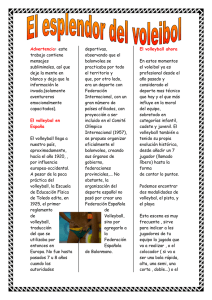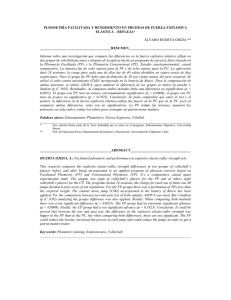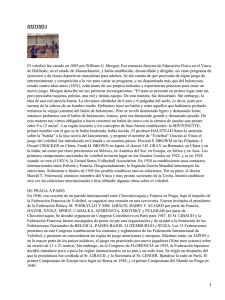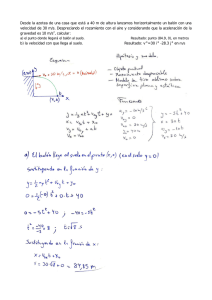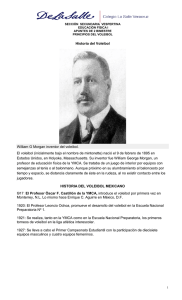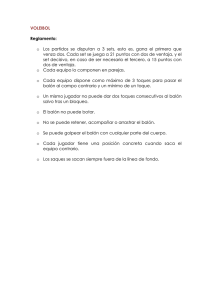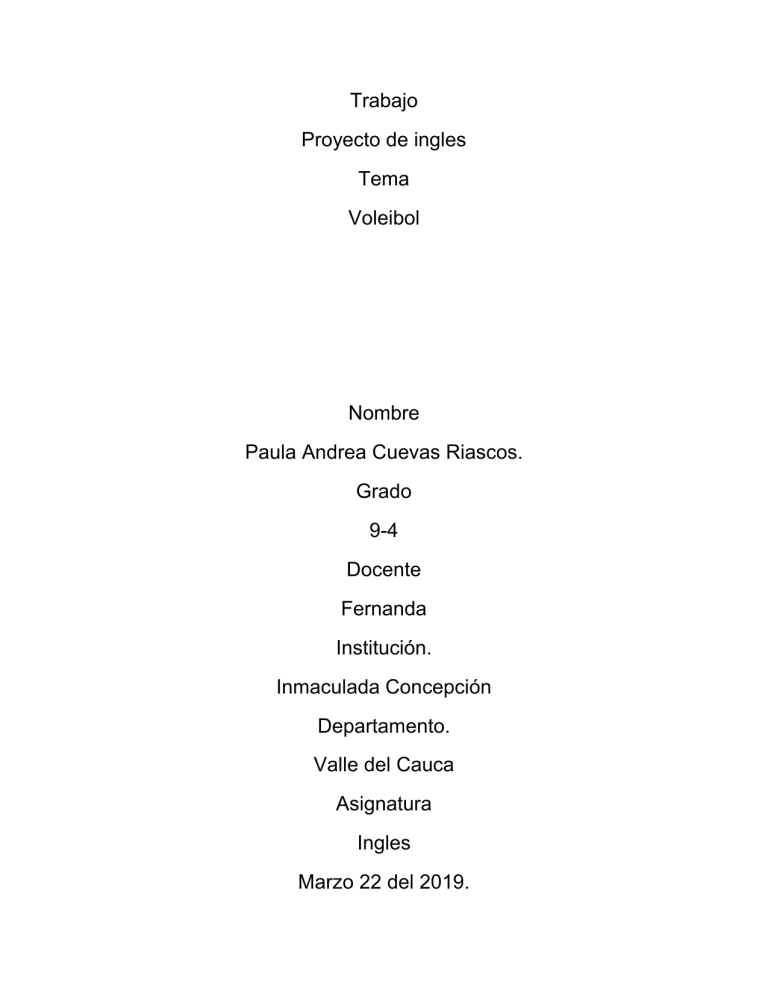
Trabajo Proyecto de ingles Tema Voleibol Nombre Paula Andrea Cuevas Riascos. Grado 9-4 Docente Fernanda Institución. Inmaculada Concepción Departamento. Valle del Cauca Asignatura Ingles Marzo 22 del 2019. Proyecto de Ingles Paula Andrea Cuevas Riascos 9-4 CONTENIDO Introducción………………………………………………….pag. 4 Que es el Voleibol Técnicas y Definición del Voleibol Como se juega el Voleibol Conformación de un equipo de Voleibol Reglas básicas Historia del Voleibol Los 4 mejores voleibolistas de la historia La mejor voleibolista del mundo Imágenes INTRODUCCION Este proyecto es basado en la necesidad de dar a conocer uno de los deportes no tan vistos pero si conocidos a nivel mundial, además que los cambios reglamentarios, implementados en los últimos años han propiciado un cambio a un voleibol más ofensivo y atractivo para el jugador y el público, permitiendo a veces la mala aplicación de los fundamentos técnicos, especialmente a lo que se refiere a la defensa. QUE ES EL VOLEIBOL El voleibol, vóleibol, volibol, vólibol, balonvolea o simplemente vóley (del inglés volleyball),1 es un deporte que se juega con una pelota en el que dos equipos, integrados por seis jugadores cada uno, se enfrentan sobre un área de juego separada por una red central. El objetivo del juego es pasar el balón por encima de la red, logrando que llegue al suelo del campo contrario mientras el equipo adversario intenta impedir simultáneamente que lo consiga, forzándolo a errar en su intento. Surge una fase de ataque en un equipo cuando intenta que el balón toque el suelo del campo contrario mientras que en el otro equipo surge una fase de defensa intentando impedirlo. TECNICAS Saque: la acción de poner en juego el balón, lanzando o soltando el balón y golpeando con la mano. Su finalidad principal es ofensiva, marcar punto al contrario, o dificultar al máximo la recepción por parte del contrario. Está totalmente prohibido darle al balón con cualquier otra extremidad del cuerpo. Golpe bajo de antebrazos: unidas las manos por el dorso y ayudado por la flexión de las piernas, el balón es golpeado desde abajo hacia arriba por ambos antebrazos logrando así un rebote vertical con una gran elevación. Es la forma habitual de realizar la recepción del saque. Golpe de dedos o voleo: el balón se pasa utilizando suavemente las manos, por encima de la cabeza y con las yemas de los dedos hacia arriba; impulsándolo en la dirección deseada pero sin agarrarlo ni lanzarlo. Remate: acción que pone fin a una jugada ofensiva. El jugador corre, salta y golpea el balón por encima de la red tirando el balón contra el suelo. Bloqueo: toda acción destinada a interceptar el ataque del equipo contrario, saltando junto a la red, con los brazos alzados y sin meterlos en el campo contrario. Está prohibido bloquear el saque adversario. Hay tres posiciones fundamentales: Alta: posición relativamente levantada, con los pies arriba ligeramente separados, uno delante del otro, y las rodillas levemente flexionadas. Es la que coloca al cuerpo con mayor extensión del tronco y piernas, utilizable para pases y para recepciones arriba de la cintura. Media: posición intermedia. Respecto a la posición anterior varían las rodillas y tobillos, que se flexionan más. Se debe elevar el talón del pie retrasado. La posición media es la más utilizada y se manifiesta tanto en la espera de un balón como del momento del contacto con el mismo, la extensión del tronco y piernas no es total ni leve sino intermedia. Baja: posición relativamente agachada. Se flexionan y separan aún más las piernas. Del pie retrasado se elevan el talón y la planta, quedando apoyado en la punta. Esta posición permite un desplazamiento casi nulo. Si la pelota llega a caer en el suelo es punto para el lado contrario. COMO SE JUEGA EL VOLEIBOL El balón debe ser tocado o impulsado con golpes limpios, pero no puede ser parado, sujetado, retenido o acompañado. Cada equipo dispone de un máximo de tres toques para devolver el balón al campo contrario (además del contacto del bloqueo). El balón se golpea normalmente con manos y brazos. Desde hace algunos años está permitido el contacto del balón con cualquier parte del cuerpo, incluidos los pies. Una de las características más peculiares del voleibol es que los jugadores tienen que ir rotando sus posiciones a medida que van consiguiendo puntos. Los puntos se anotan cuando el balón toca el suelo en el lado de la pista de los oponentes o cuando éstos fallan una devolución. El equipo, de 6 jugadores y 6 suplentes, tiene tres golpes para devolver la pelota (además del golpe de bloqueo).La pelota se pone en juego con un saque: golpe del sacador por encima de la red hacia el campo contrario. La jugada continúa hasta que la pelota toca el suelo, va "fuera" o un equipo no logra enviarlo de regreso de forma correcta. Está prohibido tocar la red así como invadir la cancha contraria, pero se permite que las manos puedan pasar por encima de la red; está autorizado hacer cambio de jugadores con el objeto de darles descanso, y pedir tiempo para tratar de romper el ritmo del equipo contrario. Él equipo que gana una jugada anota un punto (sistema jugada punto). Cuando el equipo que recibe gana una jugada, obtiene un punto y el derecho al saque, y sus jugadores rotan una posición en el sentido de las agujas del reloj. El juego consta de 3 ó 5 sets (tiempos) 3 (femenil) 5 (varonil); cabe señalar que cada set se juega a 25puntos. Al término de cada set los equipos intercambian posiciones, salvo en el último set que se juega solamente a 15 tantos (debiendo cambiar de cancha a los 8 tantos), y con la condición de que se aventaje al rival por dos puntos; en caso contrario, se sigue jugando hasta que un equipo logre tomar ventaja de dos puntos. Las competencias se llevan a cabo bajo la supervisión de un juez de silla o principal, un segundo árbitro auxiliar, 2 jueces de línea y un anotador CONFORMACION DE UN EQUIPO DE VOLEIBOL El equipo completo lo pueden formar un máximo de 14 jugadores (12 más 2 líberos), un entrenador, un entrenador asistente, un masajista y un médico. Cada jugador se identifica por un número distinto, del 1 al 20, número que aparece tanto en la parte delantera como en la trasera de la camiseta. REGLAS BASICAS En el juego, son seis jugadores en el campo y todos deben evitar que el balón bote en el suelo. Cuando la pelota sale del campo, la contabilizamos como falta, sacando el equipo contrario. Solo es posible dar como mucho tres toques por equipo antes de mandar el balón al equipo contrario. Un mismo jugador no puede dar dos toques consecutivos, salvo que el segundo toque sea después de haber hecho un bloqueo. Es un juego en el que impera la rotación: cada jugador debe rotar la posición en el sentido de las agujeras del reloj antes de casa saque. Un jugador puede llegar a rematar cualquier altura El jugador no puede rematar a cualquier altura. Es posible que el balón toque la red va a estar en juego hasta de que un bote o se produzca una infracción. HISTORIA DEL VOLEIBOL El voleibol fue creado en febrero de 1895 por William George Morgan, entrenador deportivo de la Asociación Cristiana de Jóvenes (YMCA) en Holyoke. Morgan había realizado sus estudios en el Colegio de Springfield de la YMCA donde conoció a James Naismith quien, en 1891, había inventado el juego del baloncesto. El voleibol fue ideado en principio como una alternativa más sosegada al baloncesto, pues aunque este se adaptaba bien a los jóvenes, los miembros de mayor edad requerían un juego menos intenso. Inicialmente lo denominó Mintonette. Por tanto el baloncesto y el voleibol se inventaron al final del siglo xix en dos ciudades, Holyoke y Springfield, separadas por solo 16 km y ambos deportes surgieron en la Asociación Cristiana de Jóvenes (YMCA) difundiéndose rápidamente a nivel internacional por todas sus organizaciones asociadas. Fue diseñado para gimnasios o lugares cerrados y también se puede jugar al aire libre. Se trataba de un juego por equipos, que guardaba semejanzas con el tenis o el balonmano. Morgan desarrolló también las primeras reglas, las que contemplaban un campo de juego de 7,62 m × 15,24 m (25 pies × 50 pies) y una red de 1,98 m de altura (6 pies con 6 pulgadas). El número de jugadores era ilimitado, como así mismo la cantidad permitida de contactos con el balón. En caso de una jugada de saque erróneo, existía una segunda oportunidad, tal como en el tenis. Con motivo de la conferencia de todos los entrenadores deportivos del YMCA realizada en Springfield a comienzos del año 1896, Morgan presentó el nuevo juego y encontró buena resonancia entre sus colegas. Debido a que la pelota se juega directamente en el aire, sin que toque el suelo (lo que en inglés se denomina volley), Alfred T. Halstead propuso el nombre de volley ball. Esta propuesta se aprobó y el juego se denomina en inglés hasta hoy de igual manera, pero desde 1952 comenzó a escribirse en una única palabra: volleyball. Posteriormente, las reglas también sufrieron algunas modificaciones. El primer balón fue diseñado especialmente a petición de Morgan por la firma A. G. Spalding y Bros. de Chicopee, Massachusetts. LOS 4 MEJORES VOLEIBOLISTAS DE LA HISTORIA Por supuesto los jugadores que se mencionan a continuación no responden a un tipo de criterio de habilidad o ranking en cuanto al orden en que se les menciona, ya que cada persona puede tener un gusto diferente en cuanto a lo que busca al mencionar que un jugador de voleibol es el mejor. Obviamente, un superremate es muy espectacular, pero un jugador debe atesorar también otras características. Gilberto Godoy Filho: Se lo conoce más como Giba y nació el 23 diciembre 1976 en Brasil. En la actualidad es un ex jugador de voleibol y se lo considera de acuerdo con los máximos organismos deportivos, jugadores, periodistas y directores técnicos, como uno de los mejores jugadores que se ha visto en el planeta. Wilfrido León: Es un cubano que nació el 31 julio 1993. Fue medallista de plata del campeonato del mundo en el año 2010. Ivan Zaytsev: Es un jugador profesional de Rusia que se nacionalizó italiano. Ha pasado por varios de los clubes más importantes del país que representa y siempre se ha destacado por su habilidad y capacidad técnica. Son muchos los logros individuales que ha obtenido por su capacidad resolutiva. Mariusz Wlazly: Se trata de un jugador de voleibol polaco que tiene una historia bastante particular, más que nada porque en la primera disciplina que intentó entrenar, fue la natación. Con el paso del tiempo se dio cuenta que lo suyo en realidad era el voleibol, deporte en el que ha figurado internacionalmente y se lo reconoce como uno de los mejores. LA MEJOR VOLEIBOLISTA DEL MUNDO Ángela Leyva se convirtió en la mejor voleibolista del 2013. El portal estadounidense ‘Volleywood.net’, una página web de noticias del vóley mundial, anunció hoy que la elección de la peruana batió récord al alcanzar 1,139,016 votos. La encuesta inició con 48 voleibolistas nominadas, pero solo quedaron cuatro, entre ellas la peruana. Leyva, de tan solo 17 años y quien fue elegida como la mejor atacante en el mundial de menores que se disputó en Tailandia, disputó el primer lugar con la filipina Alyssa Valdez (20). Las otras dos nominadas, pero con menor puntuación, fue la coreana Kim Yeon Koung (25) y la tailandesa Nootsara Tomkom (28). La votación, realizada por el portal estadounidense "Volleywood.net", reconoce a la peruana por su talento, logrando quedar entre las finalistas de esta votación mundial. El apoyo a la “matadorcita” se realizó ingresando al Facebook oficial de ‘Volleywood’. La jugadora de la San Martín obtuvo 201 mil 302 ‘me gusta’ y 472 mil 658 ‘compartidos’, superando a la filipina Alyssa Valdez (22 mil ‘me gusta’ y 370 mil ‘compartidos’) , la coreana Kim Yeon Koung (1897 ‘me gusta’ y 2509 ‘compartidos’) y la tailandesa Nootsara Tomkom (13 mil ‘me gusta’ y 70 mil 989 ‘compartidos’). Por otro lado, la voleybolista peruana figura en la lista del equipo ideal junto a las mejores voleibolistas de la Superliga Brasileña, entre ellas la capitana de la selección brasilera y bicampeona olímpica, Fabiana Claudinho . IMÁGENES/ images Work English project Topic Volleyball First name Paula Andrea Cuevas Riascos. Grade 9-4 teacher Fernanda Institution. Immaculate conception Department. Cauca's Valley Subject English March 22 of 2019. English project Paula Andrea Cuevas Riascos 9-4 CONTENT • Introduction ......................................................... .pag. 4 • What is volleyball • Techniques and Definition of Volleyball • How volleyball is played • Conformation of a Volleyball team • Basic rules • Volleyball history • The 4 best volleyball players in history • The best volleyball player in the world • Images INTRODUCTION This project is based on the need to publicize one of the sports not so seen but known worldwide, in addition to the regulatory changes implemented in recent years have led to a change to a volleyball more offensive and attractive to the player and the public, sometimes allowing the misapplication of the technical foundations, especially when it comes to defense. WHAT IS VOLLEYBALL Volleyball, volleyball, volleyball, volleyball, volleyball or simply volleyball, 1 is a sport that is played with a ball in which two teams, made up of six players each, face each other on a separate playing area by a central network. The objective of the game is to pass the ball over the net, making it reach the ground of the opponent's field while the opposing team tries to simultaneously prevent it from achieving it, forcing it to err in its attempt. An attack phase arises in a team when it tries that the ball touches the ground of the opposite field whereas in the other equipment arises a phase of defense trying to prevent it. TECHNICAL • Take off: the action of putting the ball into play, throwing or releasing the ball and striking with the hand. Its main purpose is offensive, mark point to the contrary, or make difficult the reception by the contrary. It is strictly forbidden to hit the ball with any other limb of the body. • Low hit of forearms: hands joined by the back and helped by the flexion of the legs, the ball is hit from the bottom up by both forearms thus achieving a vertical rebound with a high elevation. It is the usual way to perform the reception of the serve. • Fingertip or volley: the ball is passed using the hands gently, above the head and with the fingertips facing upwards; pushing it in the desired direction but without grabbing it or launching it. • Auction: action that ends an offensive play. The player runs, jumps and hits the ball over the net throwing the ball against the ground. • Blocking: any action intended to intercept the attack of the opposing team, jumping next to the net, with arms raised and without putting them in the opposite field. It is forbidden to block the opponent's serve. There are three fundamental positions: • High: relatively raised position, with the feet up slightly apart, one in front of the other, and the knees slightly bent. It is the one that places the body with the largest extension of the trunk and legs, usable for passes and for receptions above the waist. • Medium: intermediate position. With respect to the previous position, the knees and ankles vary, which flex more. The heel of the delayed foot should be elevated. The average position is the most used and manifests both in waiting for a ball as the moment of contact with it, the extension of the trunk and legs is not total or mild but intermediate. • Low: relatively low position. The legs are flexed and separated further. The heel and the plant rise from the back foot, resting on the tip. This position allows for almost zero displacement. If the ball comes to fall on the ground is point to the opposite side. HOW THE VOLLEYBALL IS PLAYED The ball must be touched or driven with clean punches, but it can not be stopped, held, held or accompanied. Each team has a maximum of three touches to return the ball to the opposite field (in addition to blocking contact). The ball is hit normally with hands and arms. For some years it has been possible to contact the ball with any part of the body, including the feet. One of the most peculiar characteristics of volleyball is that players have to rotate their positions as they get points. Points are scored when the ball hits the ground on the side of the opponents' court or when they miss a return. The team, of 6 players and 6 substitutes, has three strokes to return the ball (in addition to the blocking hit). The ball is put into play with a serve: hit the server over the net to the opposite field. The play continues until the ball touches the ground, goes "out" or a team fails to send it back correctly. It is forbidden to touch the net as well as to invade the opposing court, but the hands are allowed to pass over the net; is authorized to change players in order to give them rest, and ask for time to try to break the rhythm of the opposing team. The team that wins a play scores a point (point played system). When the receiving team wins a play, they get one point and the right to serve, and their players rotate one position clockwise. The game consists of 3 or 5 sets (times) 3 (female) 5 (male); It should be noted that each set is played at 25 points. At the end of each set the teams exchange positions, except in the last set that is played only at 15 points (having to change the court to 8 points), and with the condition that it is ahead of the opponent by two points; otherwise, it is still played until a team manages to take advantage of two points. The competitions are conducted under the supervision of a seat or head judge, a second assistant referee, 2 line judges and a scorer. CONFORMATION OF A VOLLEYBALL TEAM The entire team can be formed by a maximum of 14 players (12 plus 2 liberos), a coach, an assistant coach, a masseuse and a doctor. Each player is identified by a different number, from 1 to 20, a number that appears on both the front and the back of the shirt. BASIC RULES • In the game, there are six players on the field and everyone must prevent the ball from bouncing on the ground. • When the ball leaves the field, we count it as a foul, removing the opposing team. • It is only possible to give as many as three touches per team before sending the ball to the opposing team. The same player can not give two consecutive touches, unless the second touch is after having made a block. • It is a game in which rotation prevails: each player must rotate the position in the direction of the clock's pitches before taking home. • A player can reach any height • The player can not finish at any height. • It is possible that the ball touches the net will be in play until a pot or a violation occurs. VOLLEYBALL HISTORY Volleyball was created in February 1895 by William George Morgan, sports coach of the Young Men's Christian Association (YMCA) in Holyoke. Morgan had studied at the Springfield College of the YMCA where he met James Naismith who, in 1891, had invented the game of basketball. Volleyball was originally conceived as a more sedate alternative to basketball, because although it suited young people well, older members required a less intense game. Initially he named it Mintonette. Therefore basketball and volleyball were invented at the end of the nineteenth century in two cities, Holyoke and Springfield, separated by only 16 km and both sports arose in the Young Men's Christian Association (YMCA), quickly spreading internationally through all its partner organizations. . It was designed for gyms or enclosed spaces and can also be played outdoors. It was a team game, which had similarities with tennis or handball. Morgan also developed the first rules, which contemplated a playing field of 7.62 m × 15.24 m (25 feet × 50 feet) and a net of 1.98 m in height (6 feet with 6 inches). The number of players was unlimited, as well as the allowed number of contacts with the ball. In the case of a wrong serve, there was a second chance, just like in tennis. On the occasion of the conference of all the YMCA sports coaches held in Springfield at the beginning of 1896, Morgan presented the new game and found good resonance among his colleagues. Because the ball is played directly in the air, without touching the ground (what in English is called volley), Alfred T. Halstead proposed the name of volley ball. This proposal was approved and the game is called in English until today in the same way, but since 1952 began to be written in a single word: volleyball. Subsequently, the rules also underwent some modifications. The first balloon was specially designed at the request of Morgan by the firm A. G. Spalding and Bros. of Chicopee, Massachusetts. THE 4 BEST VOLLEYBALLISTS IN HISTORY Of course the players mentioned below do not respond to a type of skill or ranking criteria in terms of the order in which they are mentioned, since each person may have a different taste in terms of what they are looking for when they mention that a player Volleyball is the best. Obviously, a superremate is very spectacular, but a player must also treasure other characteristics. • Gilberto Godoy Filho: He is known more as Giba and was born on December 23, 1976 in Brazil. He is currently a former volleyball player and is considered in agreement with the highest sports organizations, players, journalists and technical directors, as one of the best players that has been seen on the planet. • Wilfrido León: He is a Cuban who was born on July 31, 1993. He was a silver medalist of the world championship in 2010. • Ivan Zaytsev: He is a professional Russian player who was nationalized Italian. He has gone through several of the most important clubs in the country he represents and has always stood out for his skill and technical ability. There are many individual achievements that it has obtained due to its resolutive capacity. • Mariusz Wlazly: This is a Polish volleyball player who has a very particular history, more than anything because in the first discipline he tried to train, it was swimming. With the passage of time he realized that his was really volleyball, a sport in which he has figured internationally and is recognized as one of the best. THE BEST VOLLEYBALLIST IN THE WORLD Angela Leyva became the best volleyball player of 2013. The US portal 'Volleywood.net', a news website of world volleyball, announced today that the election of the Peruvian beat record reaching 1,139,016 votes. The survey began with 48 nominated volleyball players, but only four remained, among them the Peruvian one. Leyva, only 17 years old and who was chosen as the best attacker in the world junior tournament that took place in Thailand, disputed the first place with the Filipino Alyssa Valdez (20). The other two nominees, but with a lower score, were Korean Kim Yeon Koung (25) and Thai Nootsara Tomkom (28). The vote, made by the US portal "Volleywood.net", recognizes the Peruvian for her talent, managing to be among the finalists of this world vote. The support to the "matadorcita" was made entering the official Facebook of 'Volleywood'. The San Martín player obtained 201 thousand 302 'likes' and 472 thousand 658 'shared', surpassing the Filipino Alyssa Valdez (22 thousand 'likes' and 370 thousand 'shared'), the Korean Kim Yeon Koung (1897 'I like' and 2509 'shared') and the Thai Nootsara Tomkom (13 thousand 'I like' and 70 thousand 989 'shared'). On the other hand, the Peruvian volleyball player is on the list of the ideal team along with the best volleyball players of the Brazilian Superliga, among them the captain of the Brazilian team and two Olympic champion, Fabiana Claudinho.
